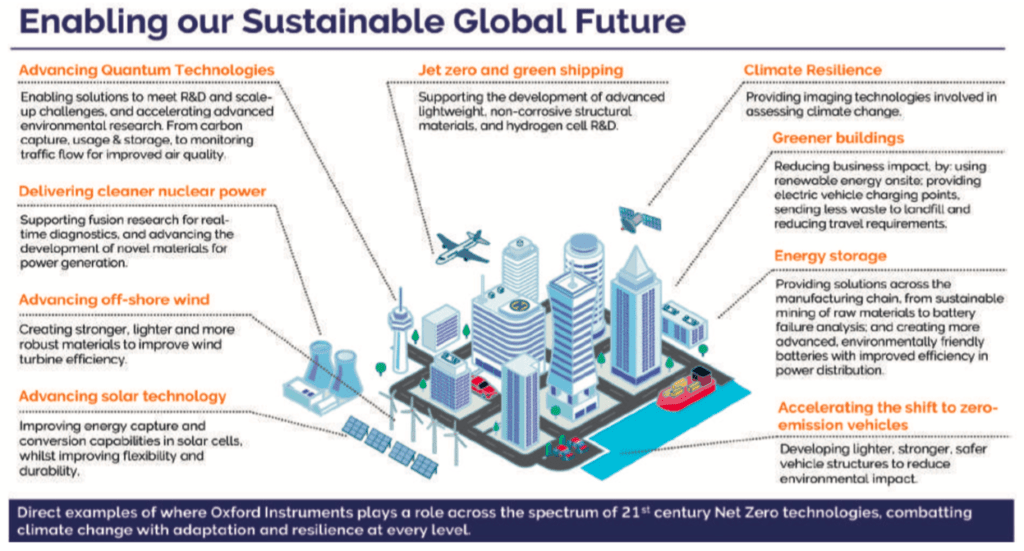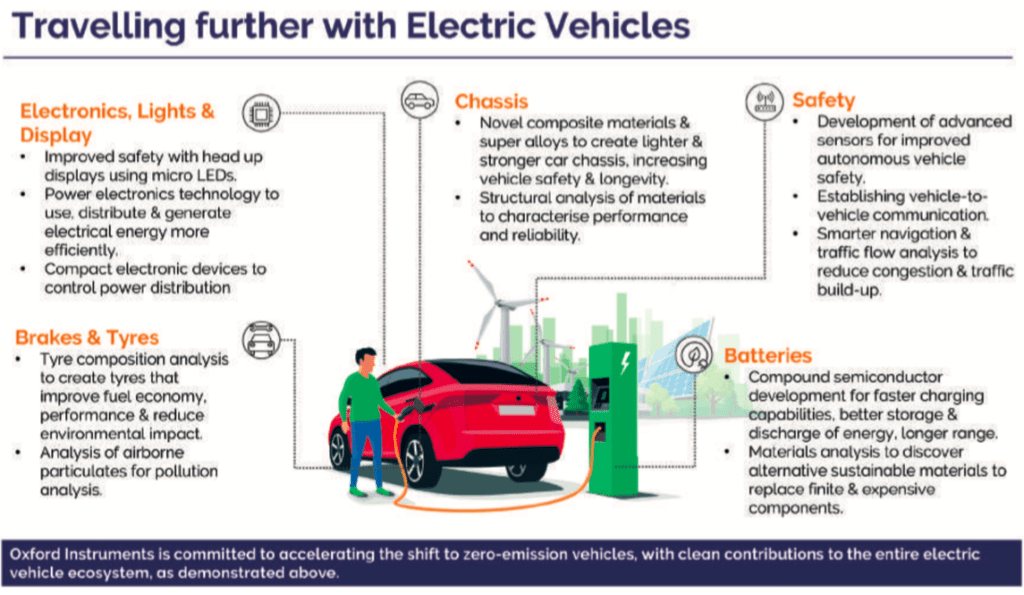In the fourth in our COP26 series, we look at how companies like Oxford Instruments, Thoughtworks and XAG are driving the development of technologies that enable clean energy, zero-emission vehicles and carbon capture
The 20th century saw unprecedented technological advances. However, in our quest for progress, we failed to heed the impact that our industries were having on the planet. Although we now know that human activity started influencing the climate as early as the 1830s, it wasn’t until 1988 that Dr James Hansen, then director of NASA’s Institute for Space Studies, stated “The greenhouse effect has been detected, and it is changing our climate now.”
Nearly 35 years later, a range of approaches have been developed to address the problem. Unfortunately, we cannot simply reverse the damage, but we can adapt our actions and technologies to ensure no further damage incurs, and we can build climate resilience, in terms of our ability to anticipate, prepare for, and respond to climate disturbances.
As leading industrial nations, both the UK and China have a moral responsibility and practical ability to impact greenhouse gas emissions. Perhaps even more importantly, nations have a responsibility and ability to work together to address shared global challenges.
One example of recent China–UK collaboration is the British Standards Institution’s (BSI) work with Anjie IoT, a leading Chinese technology company specialising in energy-saving and low carbon technology for clients in the construction sector, which had the objective of becoming carbon neutral. BSI took Anjie IoT through the journey to reach full carbon neutrality and demonstrate these achievements using the standard PAS 2060 Carbon Neutrality.
Advancing clean energies
In order to make the deeper cuts required to meet net zero, investment and innovation are needed to provide technologically viable and economically competitive alternatives to fossil fuels.
For example, most solar panels have efficiencies of just 15–20%, so improving the efficiencies of solar cells, through the manufacture of thin-film photovoltaic (PV) devices or the improvement of conventional PV technologies, is a key goal. Meanwhile, an obstacle for offshore wind power is the hostile environment that requires speciality steels and high strength carbon composites making the development of advanced materials for building offshore wind farms, a crucial target.
Another emerging technology is nuclear fusion of hydrogen atoms into helium — the process that powers the sun — which promises an almost limitless supply of clean energy, assuming current projects (e.g. ITER, the world’s largest fusion experiment, involving partners in Europe, Japan, China, Russia, the US, India and South Korea) are successful. Industry partners, such as Oxford Instruments, are working to enhance efficiencies and overcome practical challenges, such as the development of advanced materials needed for quality control and safety, and imaging tools for measuring ion temperatures and helium densities inside the reactor.
Irrespective of how clean energy is sourced, it must be stored for use so it can be used later as needed, rather than at the time it is generated – periods of high demand may not coincide with peak wind or solar production. Meanwhile, customers in the automotive and electronics industries require longer lifetimes, higher capacity, reduced weight, and lower costs. The solutions to both challenges lie in optimising battery performance, enhancing capacity, maximising power delivery and minimising degradation – all of which requires an understanding of materials processes at the nanoscale.
Solutions lie in optimising battery performance, maximising power delivery and minimising degradation – all of which requires an understanding of materials processes at the nanoscale, and China dominates the world’s production of new generation batteries
China dominates the world’s production of new generation batteries, and it is widely acknowledged that, by 2025, China will be producing batteries with double the capacity of those produced by the rest of the world. Oxford Instruments is just one UK company that has worked closely with Chinese partners, such as BYD and Shanghai Jiaotong University, to surmount challenges in developing batteries that promote the uptake of clean transport, making an invaluable contribution to mitigating the impacts of climate change.
Accelerating the shift to zero-emission vehicles
Calculating the environmental impact of the shift to electric cars is not straightforward. In order to make a true shift to zero-emission vehicles, the entire electric car ecosystem needs to be involved, from downstream raw materials suppliers to component manufacturers, final component products and applications.
As well as advancing battery technologies to increase driving distance, battery life, and performance in terms of energy storage and release, we need more efficient and durable tyres, better power distribution control, cleaner manufacturing, and structural materials that are more lightweight for improved fuel efficiency, as well as recyclable, durable, and tough.
These and other new technologies will ensure that electric cars are truly zero-emission, from design to drive. Furthermore, evolving connectivity and smart technologies, supported by quantum computing, should soon allow traffic flow to be monitored to improve air quality and reduce carbon emissions.
A major and often forgotten source of greenhouse gas emissions is agriculture and related activities; up to one third of global emissions according to the UN. Specifically, large-scale operations of agricultural machinery powered by fossil fuel generate large amounts of carbon dioxides, while excessive use of pesticides on farmland removes the ability of soil as carbon sink and causes soils to release carbon.
To provoke a fundamental change towards net zero farming, Chinese robotics and AI company XAG has developed the first-ever ground-air farming solutions that feature autonomous, all-electric agricultural drones and the R150 farm robot. By replacing oil-fired tractors with electric battery power, the application of agricultural drones and R150 farm robots can significantly reduce carbon emissions. Since March 2020, XAG R150 farm robots have been introduced and trialled in a variety of orchards across the UK, ranging from apple trees to strawberries to gooseberries to blackcurrant bushes.
Investing in carbon capture, usage and storage
Since CO2 emissions are considered the overriding cause of climate change, an obvious solution is to remove it from the atmosphere or capture it at the emission source. The UK and China are already working together on carbon capture, such as the China-UK Near Zero Emissions Coal (NZEC) Initiative, which has examined the merits of carbon capture and storage in China. These technologies have significant potential to reduce emissions, but current approaches are expensive, with some critics pointing out that they use considerable extra energy themselves and pose some risk of leakages.
While capture technologies are still at a relatively early stage, quantum computing is helping to accelerate research into carbon capture and sustainability. Quantum computers are especially well suited to molecular simulations, and they could also pave the way to discovering new catalysts for carbon capture, heralding a new era of scrubbing carbon directly out of the air, and into products like metals, plastics and concrete.
In fact, the uptake of quantum computing will itself have an impact on carbon footprints. Currently, global data centres consume about 1% of global electricity, while the largest supercomputers today take enough energy to power a small town. Quantum computers are estimated to be 100 million times faster than a classical computer, making them vastly more energy efficient. As the quantum revolution unfolds, the footprint of our digital lives will dramatically reduce.
Climate resilience
Climate resilience involves assessing how climate change will impact current, climate-related risks, and taking steps to better cope with these risks. Although changes to the Earth’s temperature were first recorded nearly 200 years ago, modern technologies offer far greater insights and understanding.
Innovations such as the miniaturisation of sensors, high-speed data transfer, and upgraded storage capabilities have made satellites an integral part of the climate change mission, as they provide essential information needed to understanding changes and feed into sophisticated models that predict the planet’s future.
In the UK and beyond, the Met Office is working at the forefront of weather and climate science to help people stay safe and thrive. As part of its Weather and Climate Science for Service Partnership (WCSSP) programme, it launched the Climate Science for Service Partnership (CSSP) China project in 2014. The project brings together UK and China research institutes to develop climate services that provide individuals and organisations with the climate information they need to overcome the challenges of extreme weather and climate events.
For example, CSSP China has developed UNSEEN – UNprecedented Simulation of Extremes with ENsembles – an innovative technique that simulates possible extreme weather events that haven’t yet been recorded. This helps build climate resilience by enabling a more complete estimation of risks in forward planning. The prototype urban climate services developed by CSSP China provide robust climate information for city decision-makers to plan for the future and help cities become more resilient to climate change.
Conclusion
Modern technologies offer clean, green solutions that give us the chance to save our planet from the damage of the past. Yet no country can do this alone. Climate change is a global challenge that pays no attention to national borders, and nations must work together if we are to win this race against time.
Oxford Instruments plays a role across the spectrum of net zero technologies, combating climate change with adaptation and resilience at every level. From dramatically reducing its own carbon footprint, to making important contributions to climate resilience, clean energies, zero-emission transport, and quantum technologies, we work with partners across the globe – including several prestigious institutes and organisations in China – in our mission of supporting the Green Industrial Revolution.
If we are to truly address climate change and shared global challenges, we must continue to work in partnership, encouraging cross-border collaborations and exchanges as well as uninterrupted trade with China in technologies which address these challenges.
Industry has a major role in supporting governments facing the challenges of climate change, but international collaboration is essential. This is demonstrated in the case studies presented in this chapter of UK–China collaborative projects that will help both countries achieve their net zero goals through adaptation and resilience.






